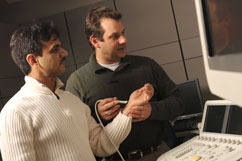Research
The overarching objectives of the research in the Computational Physiology and Clinical Inference (CPCI) Group are to enhance patient monitoring, improve clinical decision making, and better understand physiological and pathophysiological processes. We develop and use mathematical models derived from physiology, along with signal processing and estimation methods, to extract relevant information from clinical data. The models provide the constraints that allow readily observable data streams (such as waveforms of ECG, arterial blood pressure, cerebral blood flow velocity, near-infrared transmission through cerebral tissue, and/or EEG) to be related to physiological variables and parameters that are unmeasured but more directly reflective of changes in pathological state (quantities such as cardiac output, cardiac contractility and ejection fraction, peripheral resistance, intracranial pressure, cerebral metabolism and/or seizure activity). The models thereby form the basis for estimation of unmeasured quantities from measured ones, thus enabling a fuller assessment and tracking of patient state, and a more comprehensive description of the underlying physiology. Our main research efforts are currently aligned along four main projects.
1. Integrating Data, Models, and Reasoning in Critical Care
Modern intensive care units (ICUs) employ an impressive array of technologically sophisticated instrumentation to provide detailed measurements of various important variables and parameters for each patient. Providing care in the ICU is becoming an increasingly difficult task, however, because of the growing volume of relevant data that must be screened, integrated, and interpreted in order to extract clinically relevant and actionable information. This project combines the resources of an interdisciplinary team of investigators from academia (research groups from HST, CSAIL and RLE at MIT), industry (Philips Healthcare), and clinical medicine (Beth Israel Deaconess Medical Center in Boston) to develop and evaluate advanced ICU patient monitoring systems that will support improved efficiency, efficacy, and timeliness of clinical decision making in critical care. A substantial part of the effort on this project goes towards assembling a rich and extensive database of de-identified ICU data – the MIMIC II database – comprising high-resolution waveforms from bedside monitors, along with clinical notes and laboratory results, for several thousand patients. This database also constitutes the platform for much of the research on the project, and is being made available to researchers worldwide. The project is funded as a Bioengineering Research Partnership (BRP) by the National Institute for Biomedical Imaging and Bioengineering (NIBIB).2. Noninvasive Continuous Estimation of Intracranial Pressure (ICP) and Cerebral Autoregulation
Brain tissue is highly vulnerable to unbalanced oxygen demand and supply. A few seconds of oxygen deficit may trigger neurological symptoms, and sustained oxygen deprivation over a few minutes may result in severe and often irreversible brain damage. The rapid dynamics coupled to the potential for severe injury necessitate continuous, and ideally noninvasive, cerebrovascular monitoring in the populations at greatest risk for developing or exacerbating brain injury. One of the key variables to monitor in patients with brain injury is intracranial pressure (ICP), which determines the pressure on brain tissue and also affects cerebral perfusion. Current measurement modalities for ICP require the penetration of the skull and the placement of a pressure-sensitive probe in the brain parenchyma or cerebral fluid spaces. With colleagues from neurosurgery, vascular neurology, internal and critical care medicine (Beth Israel Deaconess Medical Center, Boston, as well as the University of Cambridge, UK), we are developing and validating non-invasive methods to assess ICP continuously and robustly in a patient-specific and calibration-free manner. Partial funding for this work has come from the Center for Integration of Medicine and Innovative Technology (CIMIT) in Boston, as well as from NIBIB via the BRP project described above.


